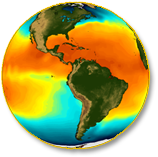Shared Socioeconomic Pathways (IPCC 6th Report)
The IPCC sixth assessment report shows that the world will likely reach or exceed 1.5 degrees Celcius (degrees C) warming within the next two decades. After that, climate impacts depend on actions taken in the very near future, as outlined in the following Shared Socioeconomic Pathways (SSP) described in the 6th IPCC Report.
SSP1 - Optimistic: 1.5 degrees C (2.7 F) by 2050
SSP1-1.9:
The IPCC’s most optimistic scenario describes a world where global CO2 emissions are cut to net zero around 2050. Societies switch to sustainable practices, shifting from economic growth to well-being. Extreme weather is still more common than 20th century events, but the worst impacts of climate change are avoided. SSP1 is the only scenario that meets the goals of the Paris Agreement.
SSP2 – Next Best Scenario: 2 degrees C by 2100
SSP1-2.6:
In the next-best scenario, global CO2 emissions are cut severely, but not as fast, reaching net-zero after 2050. It imagines the same socioeconomic shifts towards sustainability as SSP1-1.9. Temperatures stabilize closer to 2 degrees C (3.6 degrees F) by the end of the century and society adjusts to a warmer climate with more extreme weather events..
SSP3 – Middle of the Road: 2.7 degrees C by 2100
SSP2-4.5:
This is a “middle of the road” scenario. CO2 emissions hover around current levels before starting to fall mid-century, but do not reach net-zero by 2100. Socioeconomic factors follow their historic trends, with no notable shifts. Progress toward sustainability is slow, warming continues upward, and .
SSP 4 – Dangerous: 3.6 degrees C by 2100
SSP3-7.0:
On this path, emissions and temperatures rise steadily and CO2 emissions roughly double from current levels by 2100. Countries become more competitive with one another, shifting toward national security and ensuring their own food supplies. By the end of the century, average temperatures have risen by 3.6C.
SSP 5 – Catastrophic Warming: 5 degrees C by 2100
SSP5-8.5:
This carbon-intensive pathway would see temperatures climb as high as 5.7 degrees C (10.3 degrees F) higher than pre-industrial levels by the end of the century. To put that in perspective, the world has not experienced global warming of more than 2.5 degrees C in the past 3 million years.
In every scenario, warming will continue for at least a few decades. Sea levels will continue rising for hundreds of years, and the Arctic will be free of sea ice in a summer month in the coming decades. But how quickly seas rise and how dangerous the weather might get still depends on which path the world opts to take.
Acceleration of CO2-reduction is imperitive.
